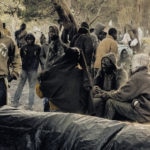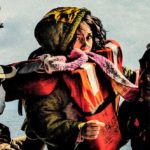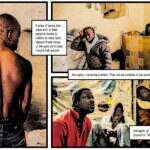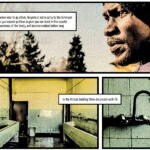Photographs become vignettes to portray refugee drama
The Crack is the field diary of two journalists trying to understand what is going on in the European Union. A journalistic comic book, published with support from the BBVA Foundation, where photographer Carlos Spottorno and journalist Guillermo Abril recount their experiences from the boundaries of a Europe in crisis.

More than 3 years of travel, 25,000 pictures, and 15 notebooks are the point of departure of The Crack, the account of a journey across the old continent portraying the wounds that are bringing the European dream to its knees.
Spottorno and Abril’s journey begins on the slopes of mount Gurugú, where thousands of Africans await for their chance to jump over the fence that separates Melilla, the Spanish autonomous city, from Morocco. And ends in the Arctic, in the Finnish woods, the surprising destination of many of the refugees crossing European borders.
And it is this refugee exodus that provides the overarching thread of the story. On the very cover of the book we meet the piercing eyes of a girl just rescued off Syrian shores. The photograph was included in the journalistic report commissioned by El País Semanal to the authors in 2014.

“The image of this Syrian girl looking straight into the camera as she is being lifted to the deck of an Italian Navy frigate is enough to get us thinking about what those eyes have seen, what that girl has been through. The horror of war and the stoutness of child whose childhood was interrupted far too soon, all in a brief moment of direct visual contact,” wrote Spottorno in the newspaper two years later.
In the beginning, the photographer thought about publishing a classical book, a compilation of his best pictures, with an introduction. But then, after securing BBVA Foundation’s support, another idea began to take shape.
“I thought it would be better to turn it into something that might reach a broader audience. I wanted to do a report, but telling the story in such a way that it would grab the readers and break barriers. I realized that what people enjoy is being told a story,” Spottorno explains.

The solution was to turn his pictures into vignettes applying a rough paper texture. And I asked Guillermo Abril to use the notes he had taken over the years and years of travelling we have shared to weave the stories, like the one of the Ivory Coast child soldiers.
We met these kids, who surprisingly still harbor hopes, took place in a frontier town in Bulgaria, in the refugee center that they share with other refugees from other conflicts. They are all looking for answers to a question that cannot be solved: “How can we continue with our trip?”
Bulgaria is not part of the Schengen Area. Once they arrive there, it’s the end of the line for refugees. They are trapped, living under conditions that have been decried repeatedly by the United Nations.

The images of this never-ending flow that is putting Europe’s solidarity to the test fill up page after page of the book, following almost a cinematographic pattern. “Even though the content is serious, the story is told in a way that keeps readers hooked,” explains Spottorno.
“I have the feeling that young people think that things are what they are and cannot be any other way,” says the photographer. The Crack tries to reach out to them with a language they understand, to tear down the wall of indifference and awaken their interest for what’s happening right now in Europe.